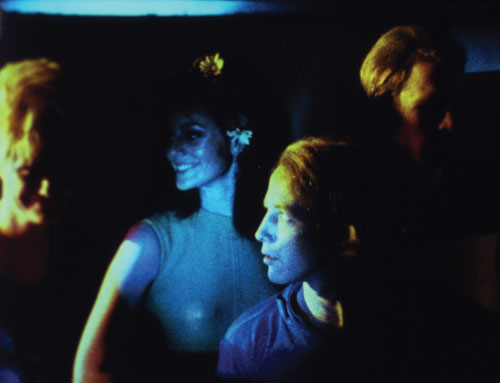|
 |

Andy Warhol’s The Chelsea Girls, produced in 1966, was his first major commercial film success. It features many of Warhol’s superstars and is built around the concept that the scenes take place in the rooms of the Hotel Chelsea in New York City.
©2007, The Andy Warhol Museum, Pittsburgh, PA, all rights reserved.
The Warhol’s Film & Video Collection
By Justin Hopper
On the sixth floor of The Andy Warhol Museum, John Giorno is still asleep. Two visitors stare up into his nostrils, inches wide as they’re projected onto the gallery wall, and both puzzle and yawn over his meaning. It's perhaps the most famous of Warhol's films: Sleep, his 1963 film debut; five hours and 21 minutes of Giorno's upper body and pillow-framed face. And while many have debated its merits, no one can argue that, around the world, people still want to see John Giorno sleeping. This autumn alone, exhibitions from Canada to Chicago to Europe have requested permission to show Sleep—just one of the nearly 300 films, and literally thousands of videotapes, made by Warhol and owned, at least in copyright, by the museum. His work is screened daily in the museum’s theater. (Check The Warhol’s online calendar for the schedule.)
“Andy Warhol worked in every medium that was available to him,” says Geralyn Huxley, The Warhol’s curator of film and video. “He started making films in 1963, and as early as 1965 had a prototype home video recorder. I’d say there are about 2,500 original videotapes in the collection. He was rather prolific.”
Warhol’s output may be prolific when measured in inches of film and stacks of videotapes, but it’s somewhat harder to document Warhol in terms of individual works. The Warhol, for example, owns hundreds of his Screen Tests—four-minute, slow-motion portraits—as well as the episodes of his television series, Fashion, Andy Warhol’s T.V., and Andy Warhol’s Fifteen Minutes. And how does one classify a film such as The Chelsea Girls, which, as Huxley points out, contains “discreet films that can be taken out and shown separately?”
“You could say that Greta Garbo made, say, 30 films,” says Huxley. “But because of the way he made his movies, you can't really do that with Warhol. He shot a lot of film, and then put it in different movies. It’s hard to say a definitive number.”
Ten years ago, the Andy Warhol Foundation, which maintained ownership of Warhol's films upon his death in 1987, granted copyright of all his film and video work to The Warhol. It’s the museum, therefore, that grants permission for the use of film and video in movies, television, and other museums’ exhibitions—which, according to Huxley, has her busier than ever. The original prints of Warhol’s films remain in the hands of the Museum of Modern Art (MoMA) in New York City, where MoMA continues a long-term project to preserve those delicate reels. Once preserved, new prints of the films are sent to The Warhol.
The reality, then, is that many of Warhol’s films have never been seen by the general public. San Diego Surf, one of the last films Warhol made, is just such an anomaly. Never released before, The Warhol and MoMA hope to show it for the first time to coincide with this year’s 20th anniversary of Warhol’s death.
“San Diego Surf was filmed just before Andy Warhol was shot in 1968,” notes Huxley. “It was never edited; there was just raw footage until Paul Morrissey edited it into a movie after Warhol's death in 1987. It’s unique because it's really the last film with Warhol behind the camera, before he turned to video. And there’s a lot of film that has yet to be preserved—film that hasn’t ever been seen by the public.” |
 Fall 2007
Fall 2007

